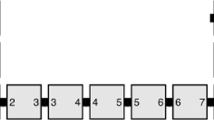Abstract
In the classical model of tile self-assembly, unit square tiles translate in the plane and attach edgewise to form large crystalline structures. This model of self-assembly has been shown to be capable of asymptotically optimal assembly of arbitrary shapes and, via information-theoretic arguments, increasingly complex shapes necessarily require increasing numbers of distinct types of tiles.
We explore the possibility of complex and efficient assembly using systems consisting of a single tile. Our main result shows that any system of square tiles can be simulated using a system with a single tile that is permitted to flip and rotate. We also show that systems of single tiles restricted to translation only can simulate cellular automata for a limited number of steps given an appropriate seed assembly, and that any longer-running simulation must induce infinite assembly.
A full version of this paper can be found at http://arxiv.org/abs/1212.4756
Research of Matthew J. Patitz supported in part by NSF grant CCF-1117672. Research of Robert Schweller supported in part by NSF grant CCF-1117672. Research of Andrew Winslow supported in part by NSF grant CDI-0941538. Research of Damien Woods Supported by NSF grants 0832824 & 1317694 (the Molecular Programming Project), CCF-1219274, and CCF-1162589.
Access this chapter
Tax calculation will be finalised at checkout
Purchases are for personal use only
Preview
Unable to display preview. Download preview PDF.
Similar content being viewed by others
References
Adleman, L., Cheng, Q., Goel, A., Huang, M.-D.: Running time and program size for self-assembled squares. In: Proceedings of 33rd Annual Symposium on Theory of Computing, pp. 740–748 (2001)
Barish, R.D., Rothemund, P.W., Winfree, E.: Two computational primitives for algorithmic self-assembly: Copying and counting. Nano Letters 5(12), 2586–2592 (2005)
Barish, R.D., Schulman, R., Rothemund, P.W., Winfree, E.: An information-bearing seed for nucleating algorithmic self-assembly. Proceedings of the National Academy of Sciences 106(15), 6054–6059 (2009)
Cannon, S., Demaine, E.D., Demaine, M.L., Eisenstat, S., Patitz, M.J., Schweller, R.T., Summers, S.M., Winslow, A.: Two hands are better than one (up to constant factors): Self-assembly in the 2HAM vs. aTAM. In: STACS 2013. LIPIcs, vol. 20, pp. 172–184. Schloss Dagstuhl–Leibniz-Zentrum fuer Informatik (2013)
Chen, H.-L., Schulman, R., Goel, A., Winfree, E.: Reducing facet nucleation during algorithmic self-assembly. Nano Letters 7(9), 2913–2919 (2007)
Cook, M., Fu, Y., Schweller, R.: Temperature 1 self-assembly: Deterministic assembly in 3D and probabilistic assembly in 2D. In: Proceedings of the 22nd Annual ACM-SIAM Symposium on Discrete Algorithms, pp. 570–589 (2011)
Doty, D., Lutz, J.H., Patitz, M.J., Schweller, R.T., Summers, S.M., Woods, D.: The tile assembly model is intrinsically universal. In: Proceedings of the 53rd Annual IEEE Symposium on Foundations of Computer Science (FOCS), pp. 302–310 (2012)
Fu, B., Patitz, M.J., Schweller, R., Sheline, R.: Self-assembly with geometric tiles. In: Czumaj, A., Mehlhorn, K., Pitts, A., Wattenhofer, R. (eds.) ICALP 2012, Part I. LNCS, vol. 7391, pp. 714–725. Springer, Heidelberg (2012)
Kari, L., Seki, S., Xu, Z.: Triangular and hexagonal tile self-assembly systems. In: Dinneen, M.J., Khoussainov, B., Nies, A. (eds.) Computation, Physics and Beyond. LNCS, vol. 7160, pp. 357–375. Springer, Heidelberg (2012)
Meunier, P.-E., Patitz, M.J., Summers, S.M., Theyssier, G., Winslow, A., Woods, D.: Intrinsic universality in tile self-assembly requires cooperation. In: SODA 2014: Proceedings of the 25th Annual ACM-SIAM Symposium on Discrete Algorithms, Portland, Oregon, pp. 752–771. SIAM (2014)
Rothemund, P.W.K.: Design of DNA origami. In: ICCAD 2005: Proceedings of the 2005 IEEE/ACM International Conference on Computer-Aided Design, pp. 471–478. IEEE Computer Society, Washington, DC (2005)
Rothemund, P.W.K., Winfree, E.: The program-size complexity of self-assembled squares (extended abstract). In: Proceedings of ACM Symposium on Theory of Computing (STOC), pp. 459–468 (2000)
Schulman, R., Winfree, E.: Synthesis of crystals with a programmable kinetic barrier to nucleation. Proceedings of the National Academy of Sciences 104(39), 15236–15241 (2007)
Soloveichik, D., Winfree, E.: Complexity of self-assembled shapes. SIAM Journal on Computing 36(6), 1544–1569 (2007)
Winfree, E.: Algorithmic Self-Assembly of DNA. PhD thesis, California Institute of Technology (June 1998)
Winfree, E., Liu, F., Wenzler, L.A., Seeman, N.C.: Design and self-assembly of two-dimensional DNA crystals. Nature 394(6693), 539–544 (1998)
Woo, S., Rothemund, P.W.: Stacking bonds: Programming molecular recognition based on the geometry of DNA nanostructures. Nature Chemistry 3, 620–627 (2011)
Woods, D.: Intrinsic universality and the computational power of self-assembly. In: MCU: Proceedings of Machines, Computations and Universality. Electronic Proceedings in Theoretical Computer Science, vol. 128, pp. 16–22 (2013)
Author information
Authors and Affiliations
Editor information
Editors and Affiliations
Rights and permissions
Copyright information
© 2014 Springer-Verlag Berlin Heidelberg
About this paper
Cite this paper
Demaine, E.D. et al. (2014). One Tile to Rule Them All: Simulating Any Tile Assembly System with a Single Universal Tile. In: Esparza, J., Fraigniaud, P., Husfeldt, T., Koutsoupias, E. (eds) Automata, Languages, and Programming. ICALP 2014. Lecture Notes in Computer Science, vol 8572. Springer, Berlin, Heidelberg. https://doi.org/10.1007/978-3-662-43948-7_31
Download citation
DOI: https://doi.org/10.1007/978-3-662-43948-7_31
Publisher Name: Springer, Berlin, Heidelberg
Print ISBN: 978-3-662-43947-0
Online ISBN: 978-3-662-43948-7
eBook Packages: Computer ScienceComputer Science (R0)




